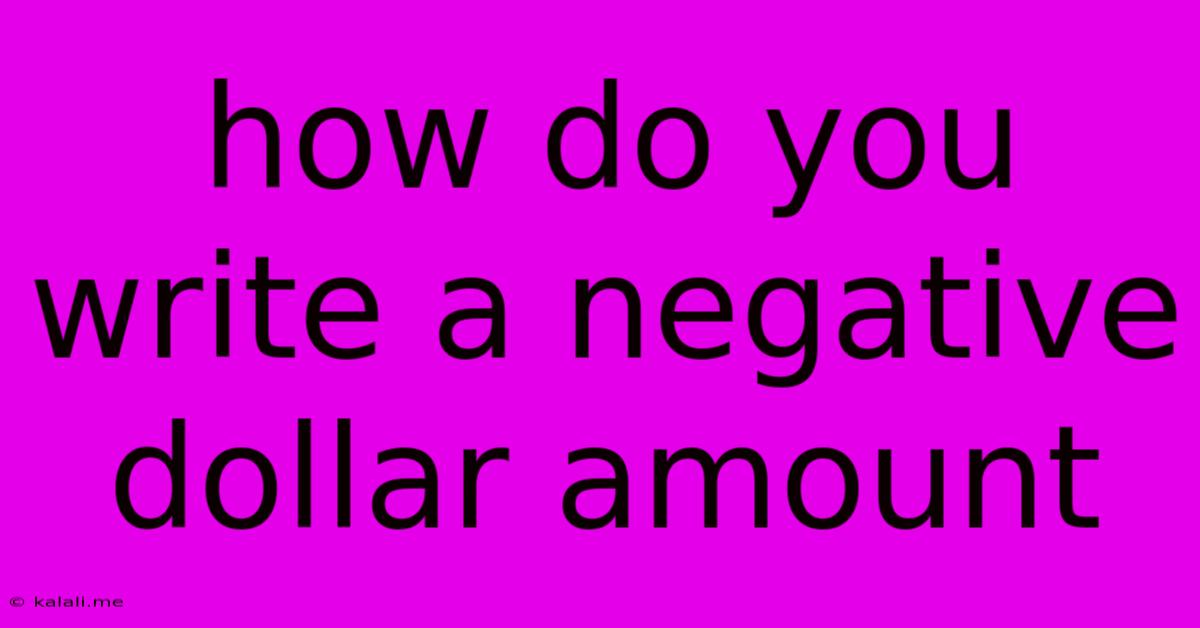How Do You Write A Negative Dollar Amount
Kalali
May 29, 2025 · 3 min read

Table of Contents
How Do You Write a Negative Dollar Amount? A Comprehensive Guide
Meta Description: Learn how to correctly represent negative dollar amounts in various contexts, including accounting, spreadsheets, and everyday writing. This guide covers different notations and best practices for clarity and accuracy.
Representing negative dollar amounts correctly is crucial for clear communication, especially in financial contexts. Whether you're dealing with accounting software, spreadsheets, or simply writing a check, understanding the proper notation ensures accuracy and avoids potential misunderstandings. This guide will walk you through several common methods and their best applications.
Common Methods for Notating Negative Dollar Amounts
There are several ways to indicate a negative dollar value, each with its own advantages and disadvantages depending on the context:
-
Parentheses: This is arguably the most common and widely accepted method, particularly in formal financial documents and accounting. Simply enclose the positive dollar amount within parentheses. For example: ($100) represents a negative $100. This method is clear, unambiguous, and easily understood. It’s ideal for financial statements, invoices, and reports where precision is paramount.
-
Minus Sign/Hyphen: A minus sign (-) placed before the dollar amount is another widely used method. For instance, -$100 clearly indicates a negative value. This is a simple and straightforward approach, often favored in spreadsheets and programming. However, be mindful of potential confusion if the minus sign is misinterpreted or poorly formatted, especially in handwritten documents.
-
Red Font: In many accounting software programs and spreadsheets, negative numbers are automatically displayed in red font. This visual cue offers an immediate understanding of the negative value. While effective in a digital context, it's not suitable for printed materials or situations where color is not consistently available.
-
Debit/Credit Notation: In double-entry bookkeeping, debits and credits represent increases and decreases in account balances, respectively. While not directly a negative sign, a credit balance in a debit account (or vice-versa) effectively represents a negative value in the context of that account. This is highly specialized and only relevant in specific accounting scenarios.
Choosing the Right Method: Context Matters
The best method for representing negative dollar amounts depends largely on the context:
-
Formal Financial Statements: Parentheses are generally preferred for their clarity and widespread acceptance.
-
Spreadsheets and Databases: The minus sign is often the most practical and efficient option, especially when dealing with large datasets. Automatic red font highlighting is also common and helpful in these environments.
-
Handwritten Documents: Parentheses are again the safest bet to minimize ambiguity. If using a minus sign, ensure it is clearly written and easily distinguishable from other marks.
-
Informal Communication: While less formal, using parentheses or a minus sign remains the most appropriate, ensuring clarity above all else.
Avoiding Ambiguity and Ensuring Clarity
No matter the chosen method, clarity should always be paramount. Consider these tips:
- Consistency: Maintain consistency throughout the document or spreadsheet. Using multiple methods for representing negative dollar amounts can lead to confusion.
- Proper Formatting: Ensure that negative signs or parentheses are clearly visible and properly positioned.
- Contextual Clues: If possible, provide additional context to help clarify the meaning of negative dollar amounts. For example, explicitly stating that a negative amount represents a loss or a debit.
- Proofreading: Always proofread your work carefully to catch any errors or inconsistencies in the representation of negative numbers.
By following these guidelines, you can ensure that your negative dollar amounts are clearly communicated and understood, minimizing the risk of misinterpretations and errors. Remember, accurate financial representation is critical in any context.
Latest Posts
Latest Posts
-
Can 4 Letter Acronym Coins Be Successful
May 30, 2025
-
When Tou Use A Thick Toilet Wax Ring
May 30, 2025
-
How Can You Tell The Gender Of A Kitten
May 30, 2025
-
How To Do First Name Or Last Name After Ms
May 30, 2025
-
Where To Put Detergent In Laundry Machine
May 30, 2025
Related Post
Thank you for visiting our website which covers about How Do You Write A Negative Dollar Amount . We hope the information provided has been useful to you. Feel free to contact us if you have any questions or need further assistance. See you next time and don't miss to bookmark.